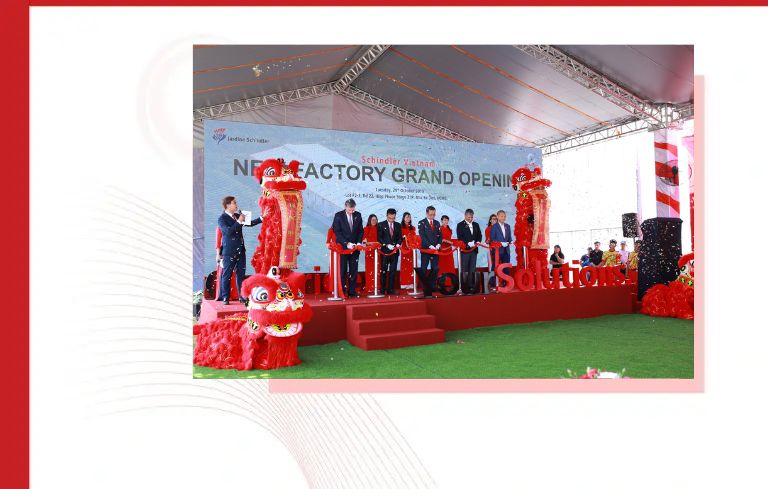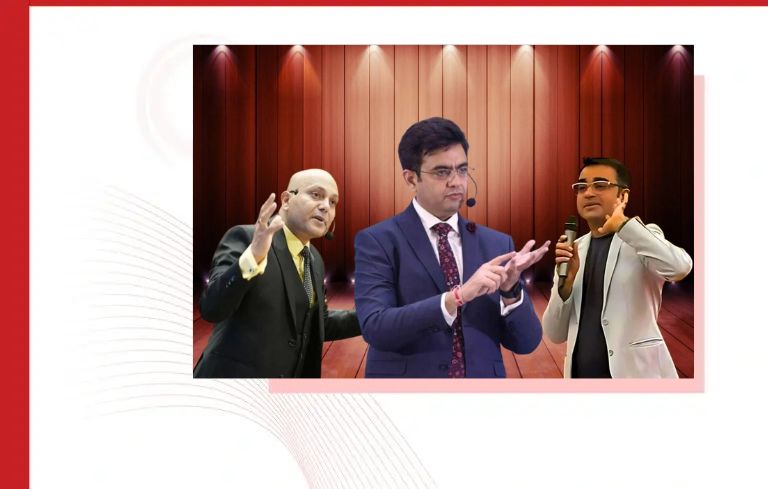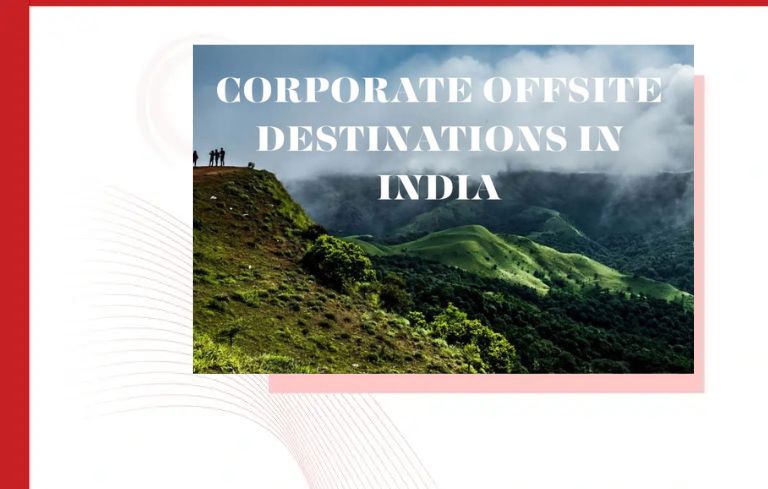Experience the essence of Kerala’s rich culture through captivating dance performances. Book Kerala’s finest dance troupe for your events. Celebrate with authentic cultural dance. Kerala Dance for Events brings the perfect blend of tradition and elegance to any occasion. Kerala, a state in the southwestern region of India, is known for its rich cultural heritage and diverse traditional dance forms. Here are some prominent dance forms from Kerala:
Here’s an elaboration on each of the mentioned dance forms from Kerala:
1. Kathakali:
Kathakali is a mesmerizing classical dance-drama that has its roots in Kerala’s rich cultural heritage. This captivating art form is a perfect blend of intricate facial expressions, vivid costumes, and elaborate makeup. The performers of Kathakali take on the roles of characters from Indian epics like the Ramayana and Mahabharata, using a unique combination of hand gestures (mudras), facial expressions (rasas), and body movements to convey emotions and narrate stories. The elaborate makeup, which involves vibrant colors and intricate designs, helps to distinguish the various characters and their traits. Kathakali performances are often accompanied by traditional music and percussion instruments that enhance the dramatic impact of the storytelling. The dance form’s elaborate training and stylized movements make it a captivating visual and emotional experience, offering audiences a window into the grandeur of Kerala’s artistic heritage.
2. Mohiniyattam:
Mohiniyattam, often referred to as the “dance of the enchantress,” is a graceful classical dance form that exudes elegance and poise. Originating in Kerala, Mohiniyattam is predominantly performed by female dancers who captivate audiences with their slow and fluid movements. The dance is a beautiful synthesis of expressions, gestures, and gentle footwork that conveys stories from Hindu mythology and folklore. Dancers portray a range of emotions through subtle facial expressions and gestures, accompanied by melodic music that complements the delicate nature of the dance. The dancers’ costumes, typically characterized by white or off-white attire adorned with golden borders, add to the visual appeal, while the themes often focus on themes of love, devotion, and spirituality. Mohiniyattam embodies the feminine grace and mystique of Kerala’s cultural heritage.
Mohiniyattam is a graceful and traditional classical dance form that originated in the state of Kerala, India. It is known for its delicate and fluid movements, expressive facial expressions, and storytelling through dance. The term “Mohiniyattam” can be translated as “dance of the enchantress,” with “Mohini” referring to a mythical celestial enchantress and “attam” meaning dance.
Key features of Mohiniyattam:
- Lyrical Movements: Mohiniyattam is characterized by slow and graceful movements that resemble the swaying of a palm tree. The dance incorporates subtle footwork, gentle hand gestures (mudras), and flowing postures, creating a poetic and aesthetic expression.
- Costumes and Makeup: Performers of Mohiniyattam wear traditional white or off-white costumes with golden borders, reflecting the attire of celestial dancers. The costume typically includes a pleated skirt, a blouse, and an elegant scarf. Minimal makeup and jewelry allow the focus to remain on the dancer’s expressions and movements.
- Facial Expressions: Facial expressions are a crucial aspect of Mohiniyattam. The dancers convey a range of emotions and narrative elements through their expressive eyes, eyebrows, and subtle smiles. The ability to convey emotions effectively is a hallmark of a skilled Mohiniyattam dancer.
- Hand Gestures (Mudras): The dance form employs a rich vocabulary of hand gestures, known as mudras, which convey specific meanings and emotions. These mudras are used to tell stories, depict characters, and express various emotions.
- Themes and Narratives: Mohiniyattam often incorporates themes from Hindu mythology, particularly stories related to Lord Krishna and other deities. Dancers use their movements and expressions to narrate these stories, bringing them to life on stage.
- Music and Instruments: The dance is accompanied by traditional Carnatic music, featuring melodic instruments like the violin and mridangam (a percussion instrument). The musical compositions enhance the mood and complement the dance movements.
- Solo Performances: Mohiniyattam is primarily a solo dance form, with the dancer taking center stage. However, group performances with multiple dancers are also occasionally seen.
- Training and Technique: Learning Mohiniyattam requires rigorous training in footwork, hand gestures, expressions, and postures. The dance demands precision, flexibility, and a deep understanding of rhythm and aesthetics.
Mohiniyattam is considered one of the eight classical dance forms of India and holds a significant place in Kerala’s cultural heritage. Its elegant and emotive style continues to captivate audiences, both in India and around the world.
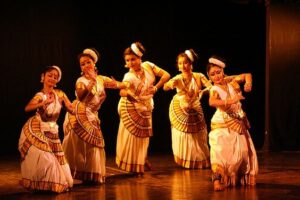
3. Koodiyattam:
Koodiyattam is a form of ancient theater that has its roots in the temples of Kerala. It’s a unique amalgamation of acting, dance, and chanting, often spanning several days for a single performance. Koodiyattam is closely linked to Sanskrit drama and showcases a highly stylized form of artistic expression. Performers convey emotions and narratives through intricate facial expressions, elaborate gestures, and precise body movements. The use of colorful and elaborate costumes, along with traditional makeup, transports the audience to a bygone era. Koodiyattam performances were traditionally associated with religious rituals and temple festivities, making them an integral part of Kerala’s cultural and spiritual landscape.
4. Thiruvathira Kali:
Thiruvathira Kali is a vibrant group dance that celebrates the essence of womanhood. Originating in Kerala, this dance is performed during the Thiruvathira festival, usually by women in circular formations. The dance involves rhythmic clapping, synchronized footwork, and graceful movements that showcase unity and harmony. The dancers often wear traditional attire and ornaments, adding to the aesthetic appeal of the performance. Thiruvathira Kali is more than just a dance; it’s a celebration of togetherness and a portrayal of the deep bonds between women, making it a cherished part of Kerala’s cultural landscape.
5. Oppana:
Oppana is a traditional Muslim dance form that adds a touch of elegance and grace to Kerala’s cultural diversity. Often performed at weddings and festive occasions, this dance involves a solo performer at the center, surrounded by a group of women who sing and clap in rhythm. The dancer’s movements are marked by their fluidity and grace, while the rhythmic clapping and footwork of the surrounding women create a harmonious atmosphere. The performance captures the essence of celebration, love, and joy, bringing communities together in festive spirit. Oppana is a beautiful representation of Kerala’s inclusivity and the convergence of diverse cultural elements.
6. Margam Kali:
Margam Kali, originating in the Syrian Christian community of Kerala, is a traditional group dance that holds spiritual and cultural significance. Women dancers form circular patterns, clapping their hands and tapping sticks rhythmically to traditional songs. The dance showcases unity, coordination, and cultural preservation. The costumes, often reflecting traditional attire, add a touch of authenticity to the performance. Margam Kali is not only a reflection of the community’s cultural heritage but also a celebration of faith and togetherness.
7. Theyyam:
Theyyam is a unique ritualistic dance form that reflects the deep spiritual connections of Kerala’s northern regions. Performers, known as “Theyyam artists,” embody deities and spirits through elaborate makeup, costumes, and trance-like movements. Theyyam performances take place in temple courtyards and other sacred spaces, often involving vibrant visuals and powerful energies. The dance is more than a mere performance; it’s a spiritual experience that brings communities together and invokes a sense of devotion. Theyyam showcases the mystical and divine aspects of Kerala’s cultural tapestry.
8. Kolkali:
Kolkali, a vibrant folk dance, encapsulates the lively spirit of Kerala’s rural festivities. With the rhythmic sound of bamboo sticks colliding, dancers create a captivating symphony of movement and music. Often performed in groups, Kolkali involves coordinated movements and energetic footwork. The dance’s simplicity and exuberance capture the essence of celebration, uniting communities in joyous revelry. Kolkali’s rustic charm and rhythmic dynamism contribute to Kerala’s rich tradition of folk arts.
Each of these dance forms is a reflection of Kerala’s cultural diversity, artistic heritage, and spiritual connections. Whether it’s the elaborate storytelling of Kathakali, the graceful expressions of Mohiniyattam, the ancient theatricality of Koodiyattam, or the vibrant celebrations of festivals through dance, each form adds a unique dimension to Kerala’s cultural mosaic.
Key features of Kolkali:
- Sticks: Kolkali is characterized by the use of bamboo sticks by the performers. The dancers hold two sticks each, which they strike rhythmically against each other while dancing. The sound of the sticks striking creates a lively and rhythmic pattern.
- Group Formation: Kolkali is typically performed in a group formation, with dancers forming rows or circles. The performers move in coordinated patterns while striking their sticks in rhythm.
- Rhythmic Patterns: The dance is accompanied by traditional folk music, which sets the rhythm for the performance. The dancers synchronize their movements and stick strikes with the beats of the music, creating an energetic and captivating display.
- Costumes: Kolkali dancers often wear traditional attire, which may include colorful mundu (a type of dhoti) and shirts. The costumes are usually vibrant and add to the visual appeal of the performance.
- Narrative Elements: While Kolkali is primarily a rhythmic dance form, it can also incorporate elements of storytelling. The dance may be used to depict mythological stories, cultural narratives, or scenes from everyday life.
- Audience Participation: Kolkali has an interactive and participatory element. Audiences often clap and cheer along with the rhythm, adding to the festive atmosphere.
Kolkali is an integral part of Kerala’s cultural heritage and is performed during various celebrations, including temple festivals, local fairs, and cultural events. The dance not only showcases the rhythmic skills of the performers but also serves as a means of preserving and passing on traditional stories and customs from one generation to another.
9. Ottamthullal –
Ottamthullal is a traditional solo dance and performance art form that originates from the Indian state of Kerala. It was created by the renowned Malayalam poet and playwright, Kunjan Nambiar, in the 18th century. Ottamthullal is known for its humorous and satirical themes, combining dance, music, and narration to entertain and engage audiences.
Key features of Ottamthullal:
- Narrative Style: Ottamthullal involves a performer (often the narrator or “vidushaka”) who narrates stories, anecdotes, and social commentaries in a humorous and satirical manner. These narratives are usually taken from classical Hindu epics like the Ramayana and Mahabharata, as well as from everyday life situations.
- Costumes and Makeup: The performer wears a traditional costume that includes a colorful and pleated lower garment (mundu) paired with a distinctive upper cloth (uttariyam). The performer also wears a unique headgear and minimal makeup, often with a painted white beard, to resemble the vidushaka character.
- Dance Movements: Ottamthullal incorporates dance movements that are simple and exaggerated, adding to the comedic and engaging nature of the performance. The dancer’s movements are synchronized with the rhythm of the music and the narration.
- Musical Accompaniment: The performance is accompanied by traditional music instruments such as the mridangam (a percussion instrument) and cymbals. The rhythm of the instruments complements the dancer’s movements and the narrative.
- Social Commentary: Ottamthullal often includes elements of social commentary and criticism, addressing contemporary issues, societal norms, and human behavior in a humorous and witty way.
- Language: The performance is typically conducted in the Malayalam language, making it accessible to the local audience.
Ottamthullal is known for its accessible and engaging style, making it popular among both rural and urban audiences. It played a significant role in the democratization of the traditional arts, as it was performed outside temple settings and was accessible to people from various backgrounds. Over the years, Ottamthullal has evolved and adapted to contemporary themes, ensuring its relevance in modern times while still preserving its traditional essence.
10. Kalaripayattu –
Kalaripayattu is an ancient Indian martial art form that originated in the state of Kerala. It is often considered one of the oldest martial arts in the world and is known for its holistic approach to physical, mental, and spiritual training. Kalaripayattu encompasses various techniques, including strikes, kicks, grappling, weaponry, and healing practices.
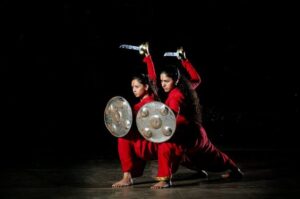
Key features of Kalaripayattu:
- Physical Techniques: Kalaripayattu involves a wide range of physical techniques, including strikes, kicks, punches, blocks, and evasive maneuvers. These techniques are designed to be effective both in self-defense and combat scenarios.
- Weaponry: Kalaripayattu practitioners also train with various traditional weapons, such as swords, shields, spears, daggers, and flexible weapons like the urumi (a whip-like sword). Weapon training is an integral part of the martial art and requires a high level of skill and coordination.
- Flexibility and Conditioning: Kalaripayattu places significant emphasis on flexibility, agility, and overall physical conditioning. Practitioners undergo rigorous training to improve their strength, endurance, and flexibility through exercises, stances, and dynamic movements.
- Breathing and Meditation: The practice of Kalaripayattu involves specific breathing techniques that synchronize with movements. Meditation and controlled breathing are also integrated into the training, promoting focus, concentration, and mental discipline.
- Healing and Massage: Kalaripayattu also includes knowledge of traditional healing techniques and massages. These methods, often derived from Ayurveda, are used to treat injuries and promote recovery after training.
- Styles and Variations: Kalaripayattu is practiced in various styles, with differences in techniques, forms, and training methods. The main styles include Northern (Vadakkan) and Southern (Thekkan) styles, each with its unique characteristics.
- Cultural Significance: Beyond its martial aspects, Kalaripayattu has cultural and historical significance in Kerala. It has influenced various other traditional art forms, including dance, and is often performed during festivals and cultural events.
Kalaripayattu has experienced a resurgence of interest in recent years due to its focus on holistic development and its relevance in promoting physical fitness, mental well-being, and self-discipline. It’s not only practiced for martial proficiency but also appreciated as a form of physical culture and traditional heritage.
11. Kolkali
Kolkali is a traditional folk dance form that originates from the Indian state of Kerala. It is known for its vibrant and rhythmic group performances involving sticks. The word “Kolkali” is derived from two Malayalam words: “kol” meaning stick and “kali” meaning dance. The dance is often performed during festive occasions, especially in rural and village settings.
Key features of Kolkali:
- Sticks: Kolkali is characterized by the use of bamboo sticks by the performers. The dancers hold two sticks each, which they strike rhythmically against each other while dancing. The sound of the sticks striking creates a lively and rhythmic pattern.
- Group Formation: Kolkali is typically performed in a group formation, with dancers forming rows or circles. The performers move in coordinated patterns while striking their sticks in rhythm.
- Rhythmic Patterns: The dance is accompanied by traditional folk music, which sets the rhythm for the performance. The dancers synchronize their movements and stick strikes with the beats of the music, creating an energetic and captivating display.
- Costumes: Kolkali dancers often wear traditional attire, which may include colorful mundu (a type of dhoti) and shirts. The costumes are usually vibrant and add to the visual appeal of the performance.
- Narrative Elements: While Kolkali is primarily a rhythmic dance form, it can also incorporate elements of storytelling. The dance may be used to depict mythological stories, cultural narratives, or scenes from everyday life.
- Audience Participation: Kolkali has an interactive and participatory element. Audiences often clap and cheer along with the rhythm, adding to the festive atmosphere.
Kolkali is an integral part of Kerala’s cultural heritage and is performed during various celebrations, including temple festivals, local fairs, and cultural events. The dance not only showcases the rhythmic skills of the performers but also serves as a means of preserving and passing on traditional stories and customs from one generation to another.
12. Pulikali –
Pulikali, also known as Kaduvakali, is a colorful and vibrant folk art form from the Indian state of Kerala. It is a unique and lively performance that involves artists painting themselves as tigers and other animals and enacting various movements and actions to portray a playful and energetic dance of the wild creatures. The term “Pulikali” translates to “tiger play” in Malayalam, the language of Kerala.
Key features of Pulikali:
- Artistic Makeup and Costumes: In Pulikali performances, participants paint their bodies with intricate tiger patterns using bright colors. The artists wear elaborate costumes that mimic the appearance of tigers or other animals. These costumes typically include a headpiece, body paint, and accessories that complete the transformation.
- Lively Dance Movements: The participants, dressed as tigers, dance and move in a way that imitates the behavior of these animals. The dance is characterized by energetic and playful movements, including mimicking pouncing, roaring, and stalking.
- Rhythmic Music and Beats: Pulikali performances are accompanied by traditional music, including drum beats and other percussion instruments. The rhythmic beats set the pace for the dancers’ movements, adding to the festive and lively atmosphere.
- Festive Occasions: Pulikali is often performed during festivals in Kerala, especially during the Onam festival, which is a significant harvest and cultural celebration in the state. It is a popular form of entertainment during this time, attracting locals and tourists alike.
- Community Participation: Pulikali involves the participation of a large number of people who come together to create an impressive and visually captivating performance. Artists from various backgrounds and age groups join in the festivities.
- Social Commentary: While Pulikali is primarily an entertaining folk art form, it sometimes incorporates elements of social and cultural commentary. The performances may touch on contemporary issues or humorous observations about society.
Pulikali is a joyful and dynamic art form that has become a celebrated part of Kerala’s cultural heritage. It not only showcases the artistic skills of the participants but also brings communities together to enjoy a lively and festive experience. The practice of Pulikali continues to evolve, incorporating new themes and ideas while maintaining its traditional essence.
13. “Kalaripayattu.” Kerala Martial Art Dance –
The martial art dance form you might be referring to from Kerala is likely “Kalaripayattu.” Kalaripayattu is an ancient Indian martial art that originated in Kerala and is often considered one of the oldest martial arts in the world. While not a dance form in the traditional sense, Kalaripayattu incorporates rhythmic movements, dynamic postures, and techniques that can be quite visually captivating, resembling dance-like sequences.
Kalaripayattu includes various striking techniques, kicks, blocks, grappling, and weaponry, and it’s practiced as a comprehensive system for physical, mental, and spiritual development. The practitioners of Kalaripayattu often engage in choreographed sequences of movements that might resemble a performance, even though the primary purpose is martial training.
In recent times, there has been an effort to integrate the artistic and cultural elements of Kalaripayattu into performances that are more accessible to audiences. These performances often combine the martial techniques with rhythmic movements, music, and choreography, blurring the lines between martial training and artistic expression. This has led to a more dance-like presentation of Kalaripayattu, making it an interesting and unique fusion of martial arts and performing arts.
14. Chavittunatakam:
Chavittunatakam is a unique Christian dance-drama that combines rhythmic footwork with storytelling. It has its origins in the Latin Catholic community of Kerala. The performers wear distinctive costumes and use exaggerated foot movements that create a distinct sound, almost like the clattering of wooden sandals, which gives the dance its name (“chavittu” means stamping or tapping). Chavittunatakam often depicts biblical stories and themes, and the performers use intricate hand gestures and expressions to convey the narratives. This dance-drama is known for its elaborate choreography, blending elements of dance, drama, and music to create a visually captivating performance.
15. Parichamuttukali:
Parichamuttukali is a lively folk dance performed by men. It involves the use of shields and wooden swords, simulating combat movements. The dance is energetic and engaging, often accompanied by traditional music and rhythmic beats. The dancers demonstrate skillful coordination as they move in formations, creating the illusion of a mock battle. Parichamuttukali showcases the valor and camaraderie of the participants, and the synchronized movements and the clashing of the shields and swords add to the overall spectacle of the performance.
16. Thirayattam:
Thirayattam is a ritualistic and folk dance-drama that is deeply rooted in Kerala’s cultural and religious practices. It is often performed in temple premises as a form of worship and entertainment. Thirayattam combines elements of mythology, folklore, and history to depict stories of gods, goddesses, and legendary figures. The dance-drama involves vibrant costumes, elaborate makeup, and rhythmic movements that vary based on the character being portrayed. Thirayattam holds spiritual significance, connecting communities to their cultural heritage and religious beliefs.
17. Kaikottikali:
Kaikottikali is a joyful group dance that is a prominent feature of the Onam festival celebrations in Kerala. Participants form circular patterns and dance to the beat of traditional music. The dance involves clapping hands and stepping in sync with the rhythm, creating a vibrant and celebratory atmosphere. Kaikottikali is often performed in traditional attire, and the dance’s simplicity and unity reflect the essence of the harvest festival, fostering a sense of togetherness and joy among the participants.
18. Krishnanattam:
Krishnanattam is a temple art form that revolves around the stories of Lord Krishna. It is performed as an offering in some temples in Kerala. The dance-drama is divided into several acts, with each act depicting a different episode from the life of Lord Krishna. Performers don colorful costumes and intricate makeup to portray various characters. The dance involves expressive facial expressions, hand gestures, and graceful movements that bring the stories to life. Krishnanattam is not only a cultural representation but also a devotional expression of the love and devotion for Lord Krishna.
19. Karakattam:
Karakattam is a traditional folk dance that showcases the skill and balance of performers. It involves dancers balancing pots on their heads while executing intricate steps and movements. Often performed during festivals and celebrations, Karakattam requires both physical dexterity and artistry. The dance’s rhythmic patterns and graceful poses, along with the sight of pots stacked high on the dancers’ heads, create an enchanting visual display.
20. Kummi:
Kummi is a traditional women’s folk dance characterized by its circular formations and rhythmic clapping. It is often performed during celebrations and special occasions. Participants form a circle and move in rhythm, clapping their hands in sync with the music. The dance’s simplicity and unity exemplify the sense of community and camaraderie among the participants. Kummi captures the essence of traditional folk celebrations, where women come together to express their joy and bond through rhythmic movements.
21. Duffmuttu:
Duffmuttu is a Muslim folk dance that showcases the cultural diversity of Kerala. It is performed with a drum called “duff,” and dancers create rhythmic patterns with their feet while moving to the beats of the drum. The dance is often accompanied by vocal performances and involves a combination of movements and expressions. Duffmuttu is performed during festivals and celebrations, embodying the cultural identity and artistic expressions of the Muslim community in Kerala.
22. Koothu:
Koothu is a folk dance form that combines humor, satire, and storytelling. It is often performed in temple premises as a part of religious rituals and entertainment. The dancers engage in exaggerated expressions, gestures, and movements to depict humorous narratives and social commentaries. Koothu is accompanied by music and percussion instruments, adding to the lively and engaging nature of the performance. The dance form’s blend of entertainment and cultural reflection makes it a unique and vibrant art form.
23. Kalampattu:
Kalampattu is a folk art form that combines dance and storytelling, often addressing social themes and issues. The performers use songs and movements to convey narratives, often using satire and wit to engage the audience. Kalampattu has its roots in the rural communities of Kerala and is a means of expressing opinions and commentary on contemporary societal matters. The dance form’s fusion of storytelling and dance creates a powerful medium for cultural expression and communication.
Each of these dance forms contributes to the rich cultural heritage of Kerala, showcasing the diverse traditions, stories, and artistic expressions that define the state’s identity.
25. Kerala fusion dance –
Kerala has a rich cultural heritage that encompasses various traditional dance forms, music, and art. In recent times, there has been a growing trend of blending traditional elements with contemporary styles to create fusion dance performances that capture the essence of Kerala’s culture while embracing modern influences. These fusion dances often combine traditional movements, costumes, and themes with modern music, choreography, and concepts.
Fusion dance in Kerala can involve a variety of combinations, such as:
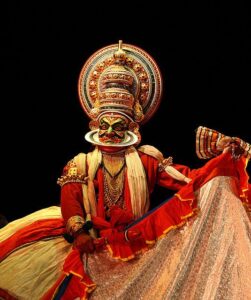
- Traditional Dance Forms with Modern Music: Dancers might perform traditional Kerala dance forms like Mohiniyattam or Kathakali to modern music genres, such as electronic, pop, or fusion music. This fusion of old and new can create a unique and captivating visual and auditory experience.
- Incorporating Folk and Contemporary Dance Styles: Dancers may integrate elements of traditional folk dance forms from Kerala with contemporary dance styles like hip-hop, jazz, or ballet. This mix of movements can add a dynamic and energetic dimension to the performance.
- Combining Dance Styles from Different Regions: Kerala fusion dance might involve combining Kerala’s traditional dance forms with those from other regions of India or even international dance styles. This cross-cultural fusion can result in exciting and diverse performances.
- Narratives and Themes: Fusion dance performances can narrate stories that bridge the gap between ancient tales and modern concepts, creating a thought-provoking and visually appealing performance.
- Costume and Makeup Adaptations: Dancers may adapt traditional costumes and makeup to create a fusion between historical aesthetics and contemporary fashion trends, giving a fresh and visually striking look.
- Use of Technology: Some fusion dance performances incorporate technology, such as projections, lighting effects, and digital art, to enhance the visual appeal and create a multisensory experience.
Fusion dance in Kerala is a way to celebrate tradition while embracing innovation. It’s an avenue for artists to explore new possibilities, attract a wider audience, and promote the rich cultural heritage of the region. These performances can be seen at cultural events, festivals, and stage shows, providing a platform for artists to express their creativity and showcase the beauty of Kerala’s diverse dance forms.
📞 Call: +91-9810617123
📧 Email: sales@hire4event.com
🌐 Visit: www.hire4event.com
🏢 Address: 214, ABC Tower, Sec-135, Noida-201301

